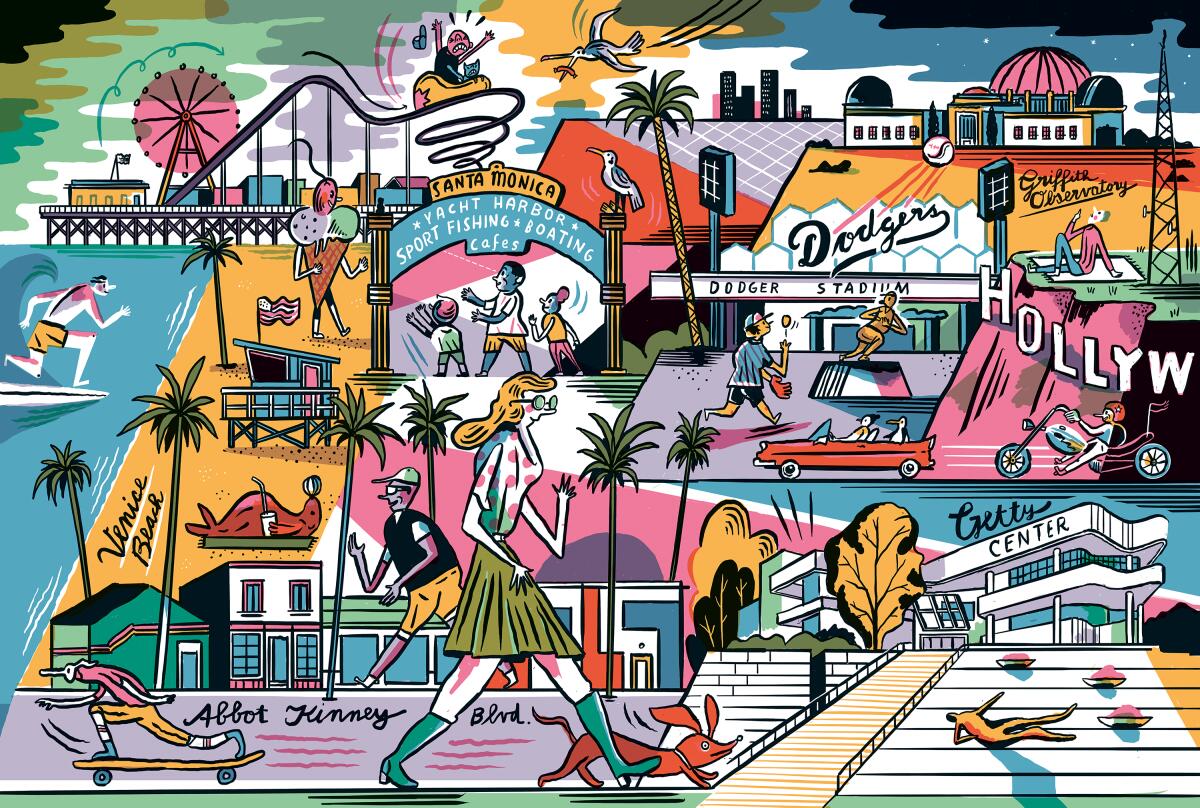
Have guests in town? Here are 22 essential L.A. spots for every tourist
- Share via
If you live in L.A., you probably know all the best spots in your neighborhood. But when family and friends come to visit, they might want to see something more impressive than the Thai place with the super-cheap happy hour just around the corner from you. That’s where this guide comes in. These are L.A.’s must-see spots: the essential locations to visit if you want to feel like you’ve lived your Hollywood tourist fantasy.
Of course, L.A. County has more world-class beaches, restaurants, museums, botanic gardens and shopping destinations than anyone could see in a year, never mind a vacation. I limited these suggestions to places that offer some unique, quintessentially L.A. experience. And that work for all ages. I also tried to include only places that are open year-round, though I bent that rule for Dodger Stadium and the Hollywood Bowl. Some ultra-popular spots didn’t make the list: We have tons of fantastic museums, but this isn’t meant to be a guide to all of them.
Planning your weekend?
Stay up to date on the best things to do, see and eat in L.A.
Bookmark this guide for the next time someone says, “I’m coming to visit you — what should we do?”
Enjoy and make plans to come back soon.
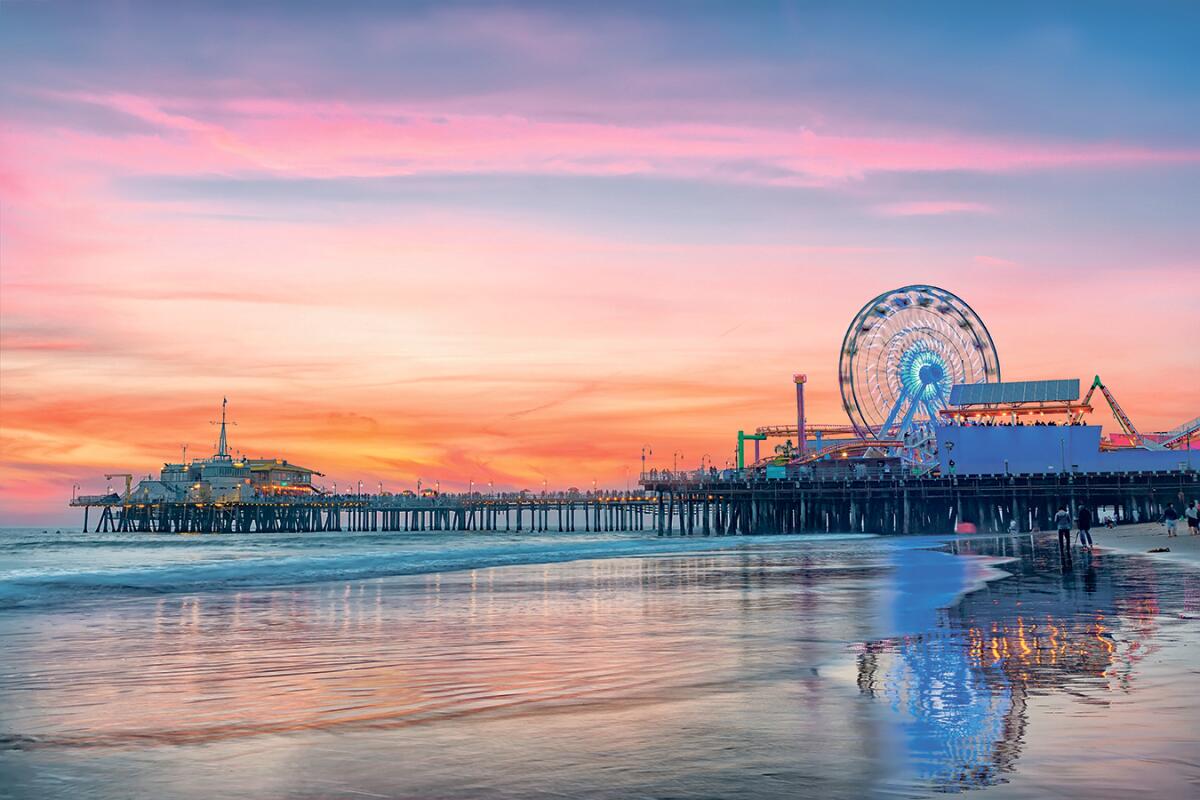
Santa Monica Pier
Pacific Park lets you buy tickets for individual rides ($6 each for the gentler kiddie rides, $12 each for the Ferris wheel and roller coaster) or all-access unlimited ride wristbands ($20 for kids under the age of 8, $40 for adults and kids 8 and older). You can rent fishing poles from a couple of places on the pier if you’d like to try your hand at a big catch. Before you go out on the pier, walk north through Palisades Park and get a look at the meme-worthy Batman/Barbie beach houses.
You don’t need to pay any admission fee for entertainment here if you don’t want to: The last time I went, I listened to a man with an electric violin do a rendition of Ariana Grande’s “7 Rings” by the roller coaster, an opera singer performing “Ave Maria” at the end of the pier and a man walking around jamming to his own beat on homemade bongos. If you stop to listen to them — which you should — make sure to tip afterward.
At the western tip of the pier, Mexican restaurant MariaSol has a big platform staircase where anyone can sit down, spread out and watch the sunset over the Pacific Ocean. If there’s a better way to end a day in L.A., I don’t know about it.
The pier is free and open to the public from 6 a.m. to 10 p.m. every day of the year. Santa Monica has a number of public parking structures that accept credit cards in the blocks around the pier. There is limited street parking, most of it metered.
Locals know: The Third Street Promenade is a lovely outdoor mall that’s walking distance from the pier.
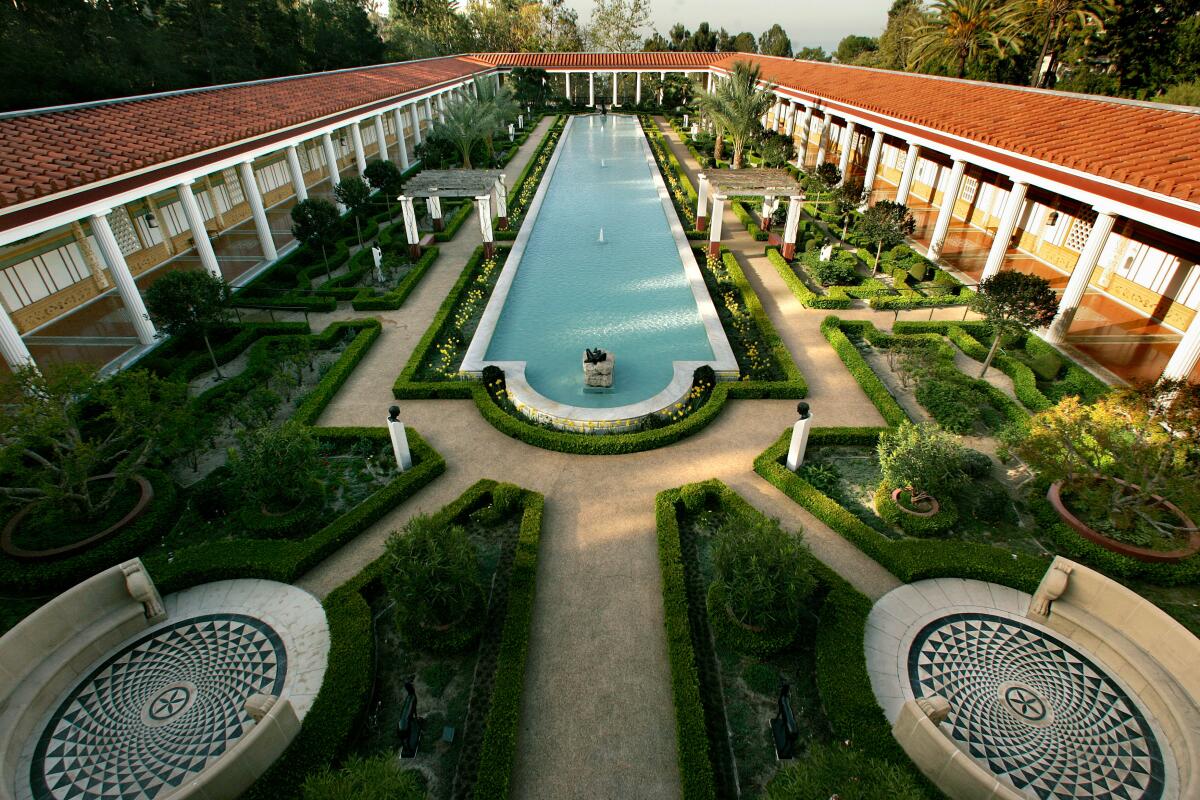
The Getty Villa
Both the Getty Villa and the Getty Center were built on the collections and fortune of J. Paul Getty, an American industrialist who was at one time the richest man in the world.
Tickets to the Getty Villa are free but require visitors to book beforehand and select a date and time. You might be able to get same- or next-day tickets online if it’s a slower week.
Docents lead tours, or you can download the GettyGuide app and bring headphones and do a self-guided version.
The Getty Villa near Malibu is a bit of a haul to get to from most places in Los Angeles. But it’s worth the time in traffic.
The Getty Villa is open from 10 a.m. to 5 p.m. every day except Tuesday, when it’s closed. You must park at the on-site parking lot — the Getty Villa will not let you walk up from the street unless you arrive via public transit.
Locals know: Download the GettyGuide app before your visit. The Villa has poor Wi-Fi and cell service.
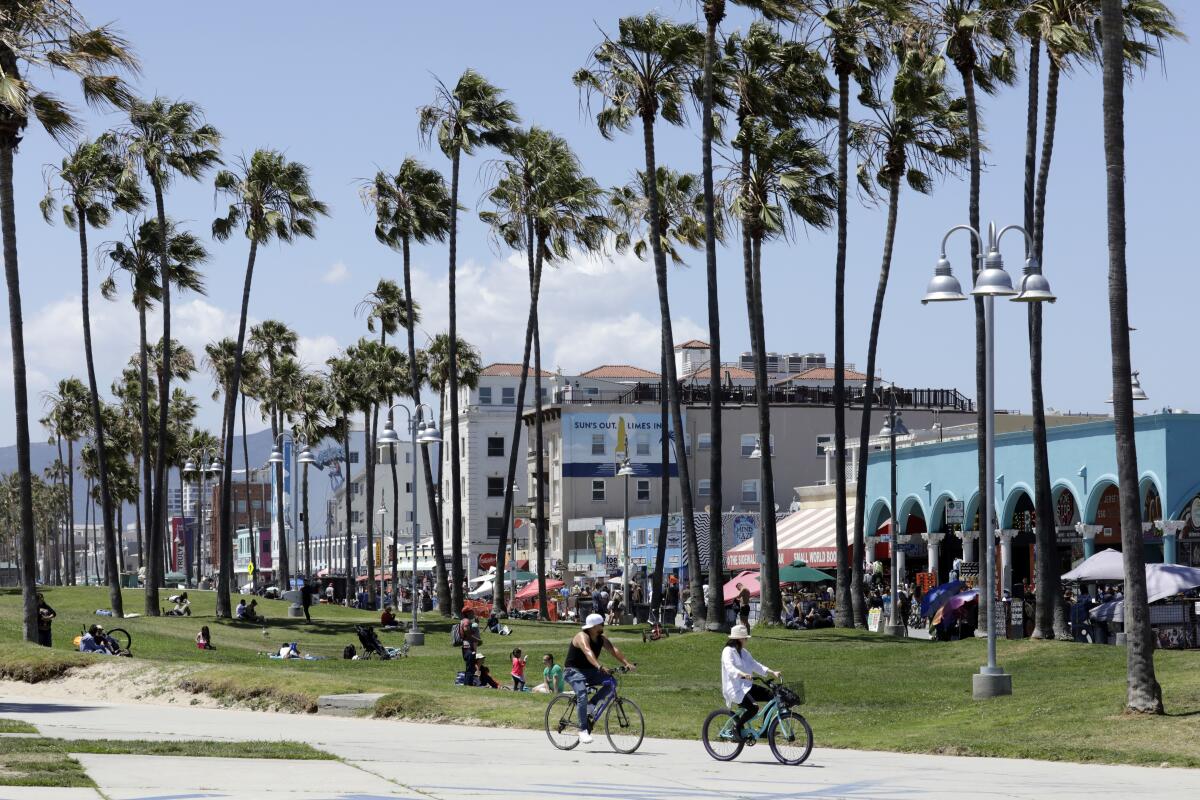
Venice Beach
You can start your visit on the beach itself. Lay out your towel, dip your toes in the Pacific Ocean, then just spend a little time soaking in the sunshine. Did you know the entire California coastline is open to the public? There is no such thing as a legal private beach here. We consider our beaches one of our most sacred public resources. No one can own them, though many have tried.
After you get your fill of beach lounging, watch skateboarders pull off death-defying moves in the Venice Beach Skatepark. Just east of that are areas of open pavement where people breakdance, roller-skate or both while crowds watch. You’ll see people making art and music all around you.
Then, join the crowds strolling the boardwalk. The quirky shops and sidewalk vendors along the two-mile stretch sell funky art, jewelry, plants, clothing, swimsuits and souvenirs. Several stores offer marijuana or CBD products, which you are likely to smell evidence of before you see. Buskers perform music and magic tricks; it’s polite to tip a couple of dollars if you linger to watch.
Veer south and check out Muscle Beach. Get food from one of the stalls along the path, which include traditional boardwalk-style offerings, as well as things like empanadas and Thai iced tea. When you need a break from the elements, browse the staff recommendations at Small World Books.
You can rent bikes (single cruisers go for around $6 to $10 per hour or $35 to $50 for the whole day, depending on which shop you rent from) and pedal along the path to the Santa Monica Pier and back.
The boardwalk is open to the public from 5 a.m. to midnight. There are lots of surface lots that charge between $10 and $20. Some accept cards, but it’s best to bring cash. There’s very limited street and metered parking, and if it’s a warm day, those spots will be nonexistent by midmorning. Some restaurants and hotels by the beach offer valet parking.
Locals know: Head to Belles Beach House, the Venice Whaler or the Del Monte Speakeasy to grab a drink after the sun goes down.
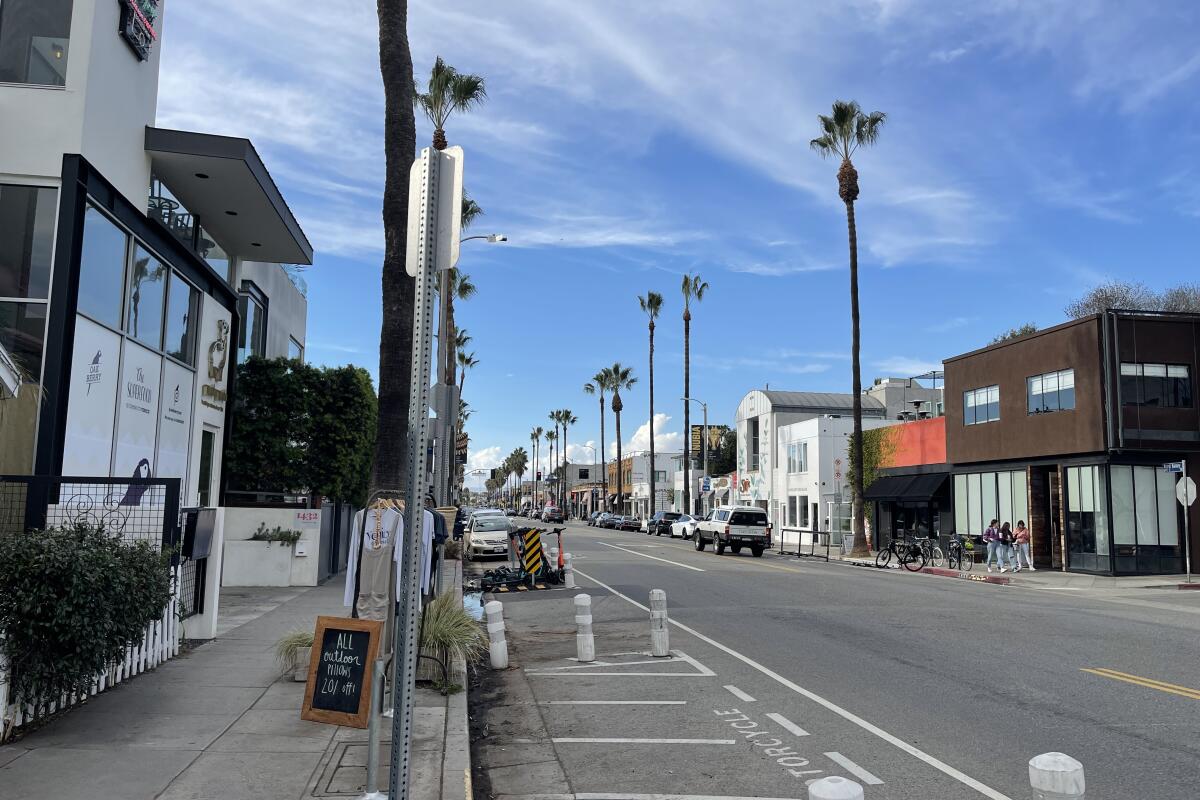
Abbot Kinney Boulevard
Food options include juice bars, pricy coffee shops and numerous options of the bowl variety (harvest, grain, açai, etc.). At the Butcher’s Daughter juice bar and cafe, sample vegetarian meals like avocado toast paired with fresh-pressed juices, natural wines or “wellness lattes” that have ingredients like rose, cardamom or three types of mushrooms (but no espresso).
There’s metered street parking and metered public lots. Meters accept credit cards. Many spots have a two-hour limit, so you’ll need to move your car if you want to stay longer. Limited free street parking is available on some residential side streets. Read signs carefully.
Locals know: The first Friday of every month there’s a First Friday Food Truck Fest starting at 5 p.m.
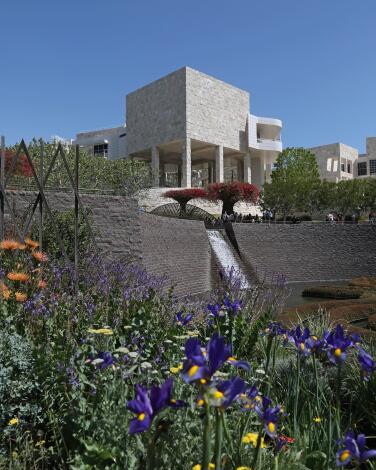
The Getty Center
You’ll park on-site, then take the Getty Center Tram — a hovertrain, specifically — up a short way to the Getty Center. The permanent collections house European art and artifacts from the Middle Ages to modernity, including paintings, illuminated manuscripts, sculptures and furniture. There are also galleries with rotating exhibitions.
Between galleries, relax and grab a bite in the central courtyard. Take in the views and the outdoor sculptures on display, and enjoy the ducks frolicking in the fountains.
After you do the museum, head out to the Central Garden. The otherworldly landscape is considered a living outdoor part of the museum’s collection.
The Getty Center shares a namesake with the Getty Villa, but the two places house different types of art and have different overall vibes. Like the Villa, tickets are free but require advance reservations.
The Getty Center is open from 10 a.m. to 8 p.m. on Saturdays and 10 a.m. to 5:30 p.m. the rest of the week; closed Monday. It’s open year-round except for New Year’s Day, Independence Day, Thanksgiving and Christmas. There is an on-site paid parking structure; because of the museum’s location, this is really your only option for parking.
If you plan to visit the Getty Villa and the Getty Center on the same day, there is a “pay once, park twice” deal on parking. More information is available on the Getty Center’s parking information page. The Getty Center and Villa are about 30 to 45 minutes’ driving distance apart, depending on traffic. If it’s rush hour on a Friday afternoon, they are two hours apart.
Locals know: Because the museum is perched on the side of a hill, the GPS sometimes gives inaccurate directions. Plug in “N Sepulveda Blvd & Getty Center Dr, Los Angeles, CA 90049” to be correctly directed to the entrance to the parking structure.
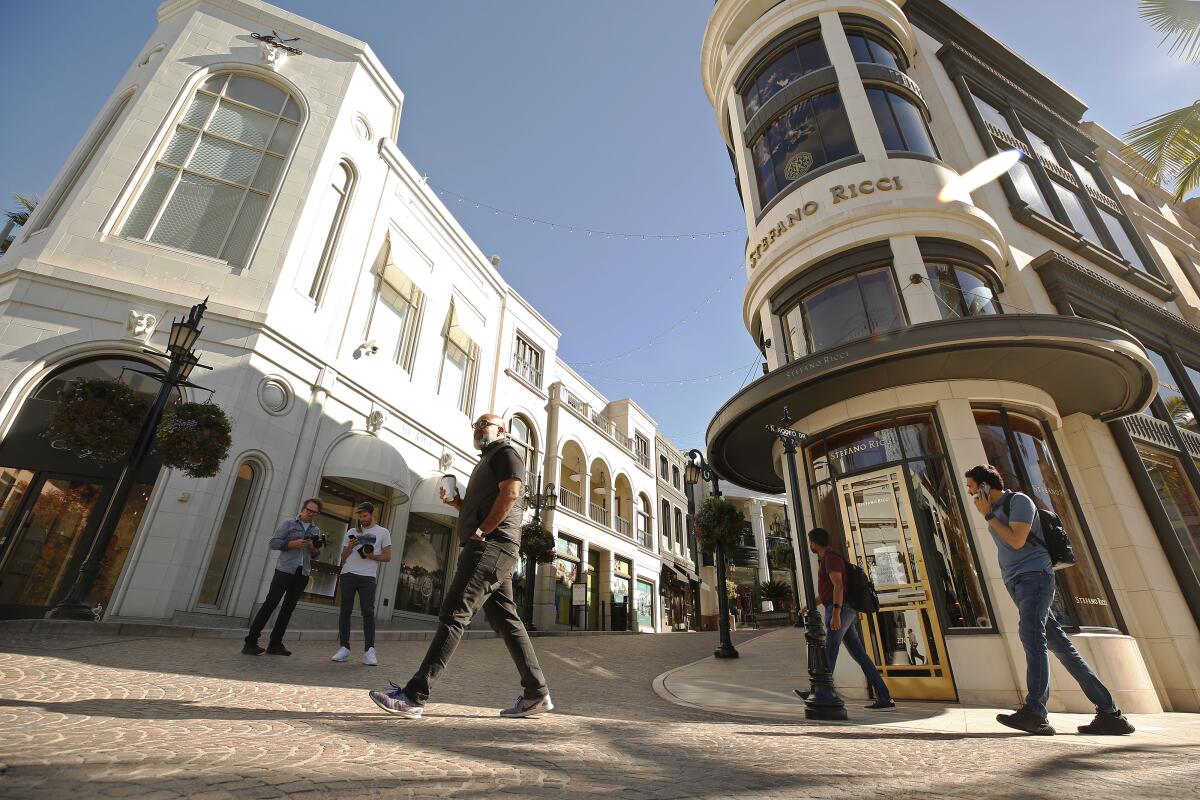
Rodeo Drive
There’s as much people-watching as there is storefront-display-peeping on offer here. You’ll see loads of other tourists, luxury cars casually parked against the curb, and a preponderance of high-end strollers and French bulldogs.
The main stretch of designer shops is ringed by high-end nail salons, cafes and smaller boutiques. If you want to be able to say, “Thanks, I bought this in Beverly Hills” after you get back home, venture east to find some nice-but-doesn’t-cost-a-paycheck department and clothing chain stores like Guess and Club Monaco.
During the winter holidays, Beverly Hills goes all out with lights and decorations. Grab dinner, then plan to go for a stroll to take in the spectacle.
Beverly Hills has a lot of public parking structures that offer two hours of free parking and take credit cards after that. There is very limited street parking — read signs carefully.
Locals know: It’s pronounced “ro-DAY-oh.”
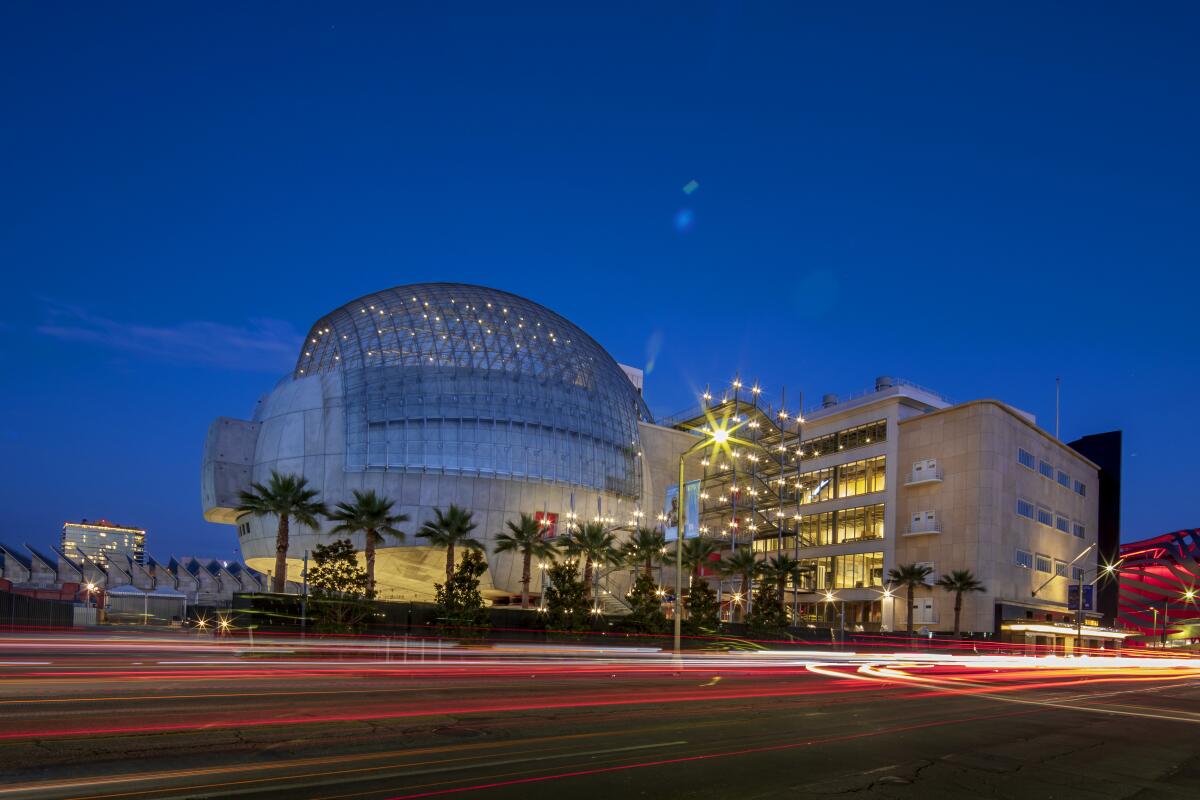
The Academy Museum of Motion Pictures
The Academy Museum doesn’t have its own dedicated parking structure, but you can park at the Pritzker Parking Garage at LACMA ($20 flat fee) or the garage at the Petersen Automotive Museum across the street ($21). There is also valet parking available just north of the museum on Fairfax Avenue that costs $17 with museum validation.
Tickets are $25 for adults, $19 for seniors, $15 for students with valid ID ages 18 and older, and free for children under the age of 18. Museum hours are 10 a.m. to 6 p.m. Sunday to Thursday and 10 a.m. to 8 p.m. Fridays and Saturdays. For $15 more, you can practice your acceptance speech while raising your statuette before a (virtual) roaring crowd in “The Oscars Experience.” Game Critic Todd Martens tried it out.
Locals know: Some free outdoor sites nearby include the “Levitated Mass” and “Urban Light” artworks at LACMA and the La Brea Tar Pits.
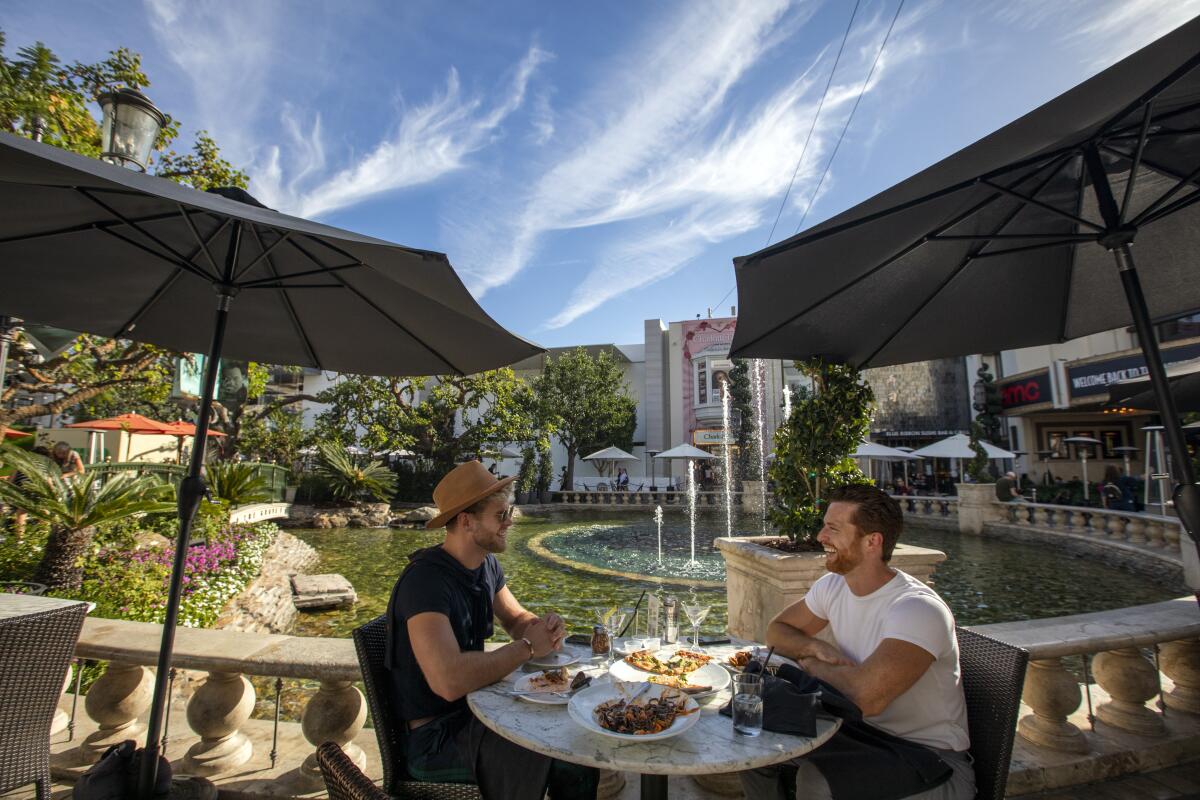
The Grove & Original Farmers Market
It’s worth visiting the place just for the sweeping vistas of the city from the roof of the parking structure, frankly. And you can look around and think to yourself, wow, the guy who owns this place was almost the mayor of Los Angeles.
Adjacent to the Grove is the Original Farmers Market. While the Grove maintains a sort of Disneyland Main Street-esque vibe and intensity, the Farmers Market feels — and is — much more relaxed. Its founders wanted to build a “village” for local farmers to ply their wares back in the 1930s.
Today, there are food stalls offering cuisines from around the world, quirky shops, actual farmers market stalls selling produce and a few artisanal grocery stores. Everyone in your group can order food from a different place and then come sit together and eat.
There is paid parking at a Grove structure and a Farmers Market lot.
Locals know: Kip’s Toyland, L.A.’s oldest toy store, sells old-fashioned toys and games.
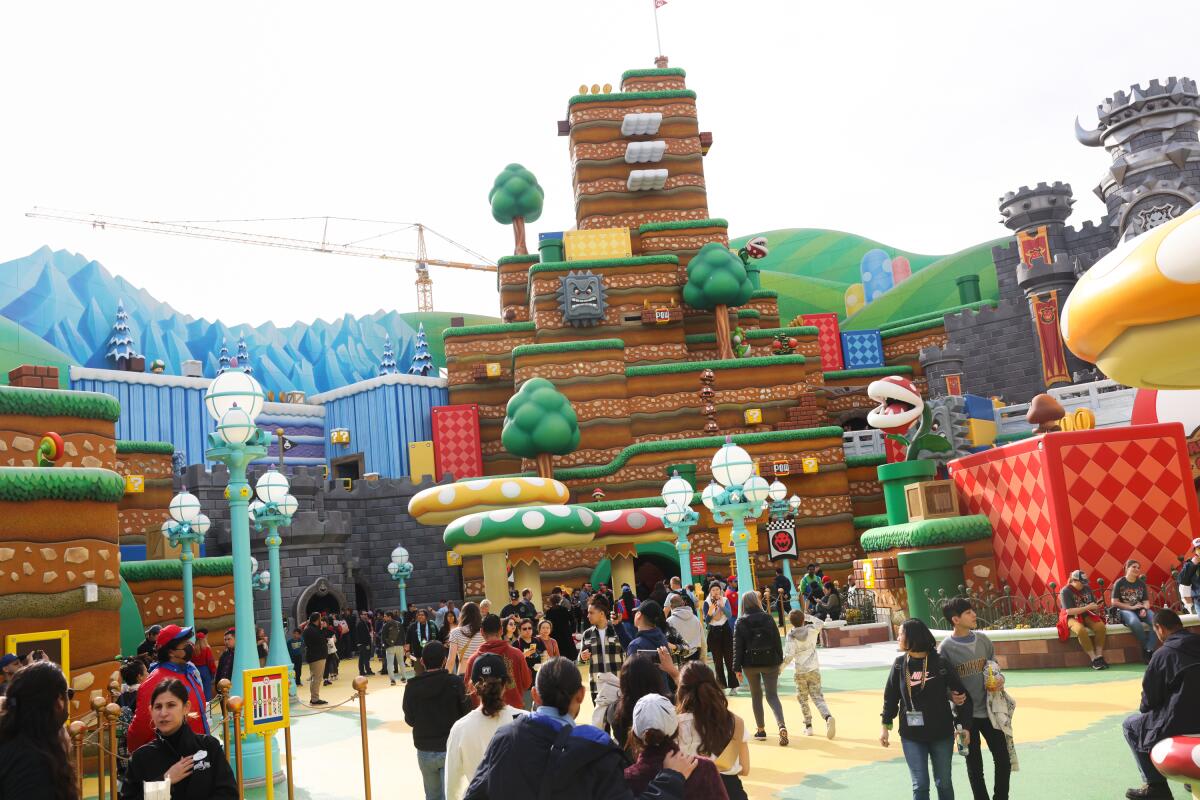
Universal Studios
Super Nintendo World opened in February, so expect lots of crowds there. Sip Butterbeer in the Wizarding World of Harry Potter, eat a giant pink doughnut with sprinkles near the Simpsons Ride, then get an ice-cold soda or beer and take in sweeping views of L.A., including several movie studio lots, while you take the escalator down to the “Jurassic World” and “Transformers” rides.
Speaking of backlots: The real Hollywood magic here isn’t on a ride. It’s on the studio tour, which is included with your ticket. A tram will take you through backlots and houses you’ll recognize from a million TV shows and movies. You’ll be driven through the downed-plane set from “War of the Worlds,” visit the picturesque town square from “The Good Place,” see a mini-show based on the “Fast & Furious” movies and get spooked by the shark from “Jaws.” The studio tour takes about an hour from start to finish. It’s open to all ages but might be a little scary or intense for young children.
Universal Studios Hollywood uses Uber-style “surge pricing” for tickets. A one-day ticket starts at $109 but can go as high as $149 per person during peak traffic days. You’ll save money buying them ahead of time online versus purchasing at the gate.
Right outside the park is Universal CityWalk, an open-air mall with a movie theater and a ton of tourist-oriented restaurants and stores. CityWalk is free to access even if you aren’t headed to the theme park.
There are several large parking structures on-site and valet parking at CityWalk. The price starts at $30 for general parking, which makes you walk through CityWalk to get to the theme park. It’s only a 10- to 15-minute walk, and there’s a lot to see.
Locals know: Rides at Universal offer “child switch,” where one parent or caregiver stays with the kid in a separate family area while the other rides the ride. Then the parents can switch places without having to start all over in line.
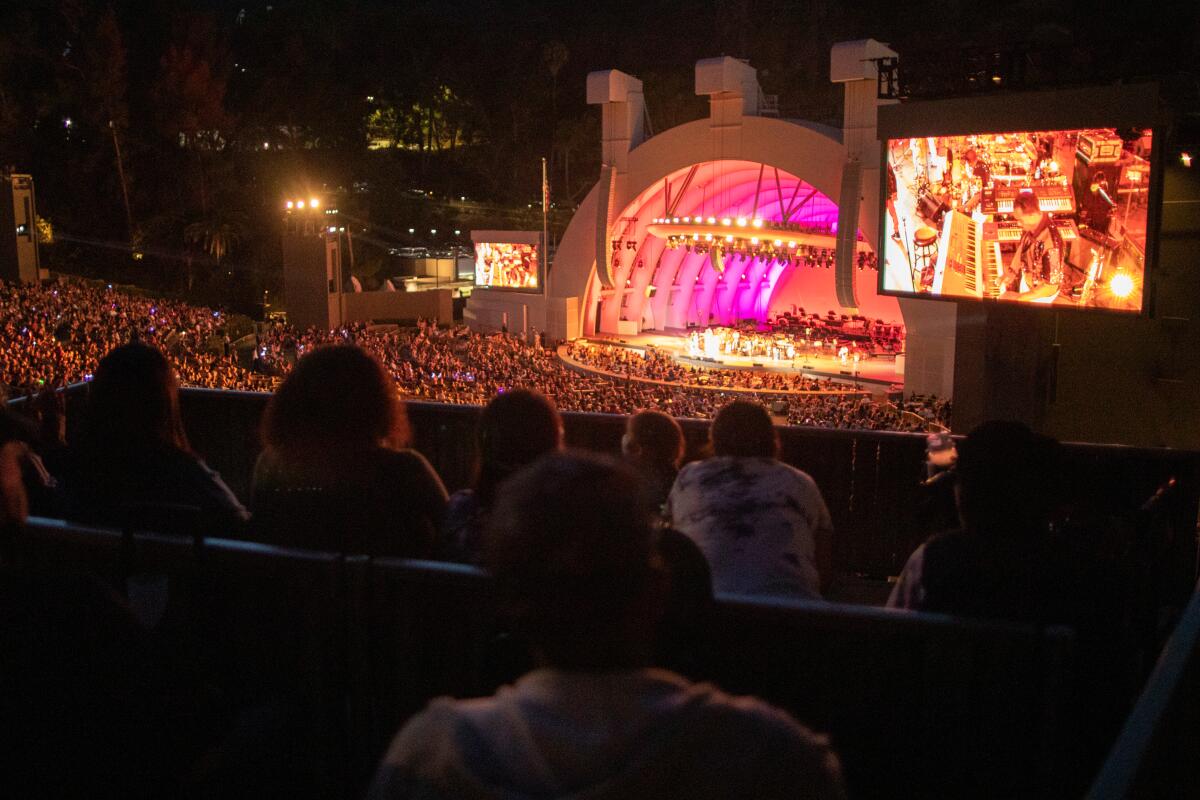
The Hollywood Bowl
Bowl tickets can range from $1 for weeknight L.A. Phil tickets to hundreds of dollars for the household-name headliners. It’s a pain in the butt to park here and then hike to your seat. And it’s not open year-round — sorry, winter visitors. But if your trip to L.A. aligns with a concert date, it’s worth visiting Hollywood’s iconic outdoor amphitheater. Sitting in the middle of a roaring crowd while fireworks go off behind the bandshell, lights glittering from the Hollywood Hills — it’s magical. Very much worth the trek.
The Hollywood Bowl will be open for the year starting in April. The official season kickoff will feature Janet Jackson and Ludacris on June 10. As usual, the season will have a mix of concerts, film screenings with live accompaniment, and special events like the annual “Sound of Music” sing-along. Gustavo Dudamel only has three years left with the Los Angeles Philharmonic, so catch him while you still can.
Subscribers who buy packages of tickets get first shot at seats. On May 2, tickets to individual regular-season events go on sale to the public.
You can park on-site at the Bowl up to three hours before the performance begins. But even the people who run the Hollywood Bowl don’t advise doing that. They say to check out Park & Ride shuttles instead. Park & Ride tickets are $7 round-trip per person in advance, or $12 per person (exact change in cash only) purchased on-site. There are also plenty of ways to get there without a car.
Gates open two hours before the performance is slated to start. Plan to arrive at least an hour before the show begins to get through security and get to your seat. There are picnic areas around the Bowl where you can enjoy your own food and drinks before the show (including some alcohol, unless it’s a lease event).
Locals know: If you’re in town during the summer, email [email protected] and ask if the L.A. Phil has rehearsals open to the public at the Bowl during your visit. You can also sometimes walk the grounds during the day.
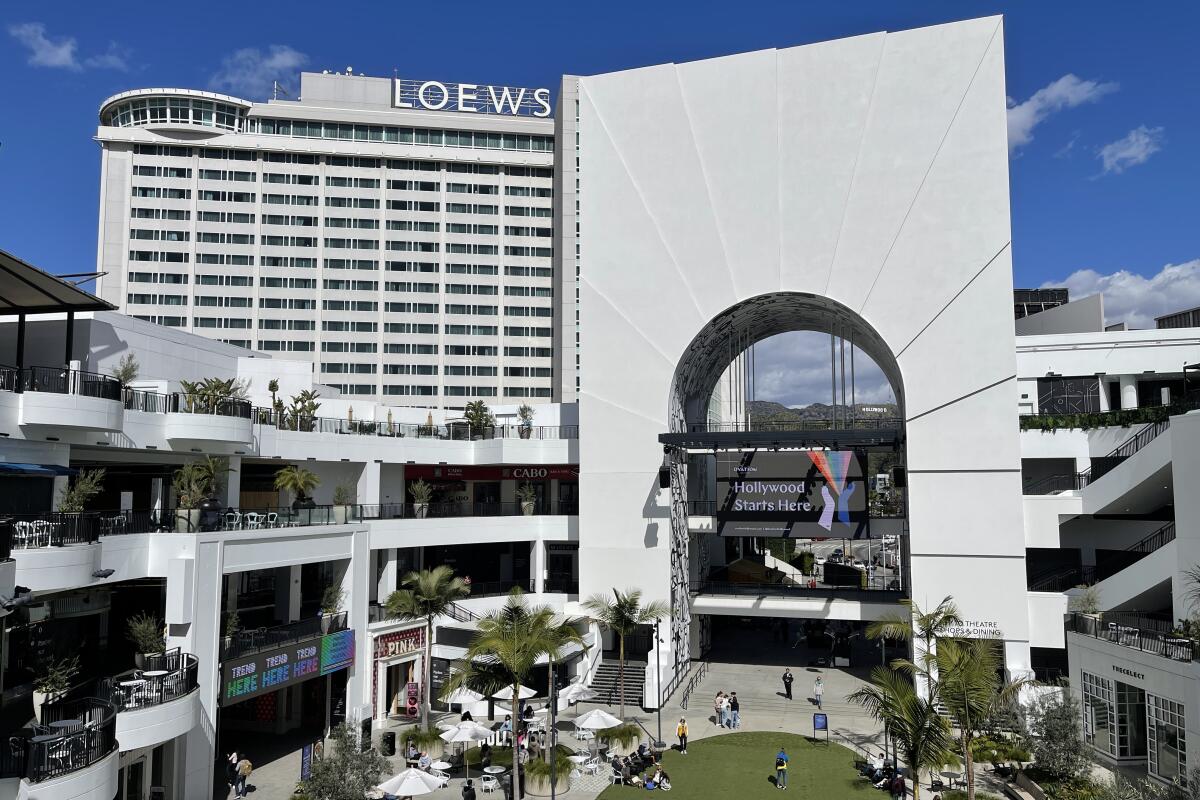
Ovation Hollywood
On the northeast corner is the Ovation Hollywood mall (formerly Hollywood & Highland). This shopping center and tourist destination is also the home of the Academy Awards. Entering from Hollywood Boulevard, you’ll walk past a purse store, a luggage store and a coffee shop and see a sweeping staircase in front of you. You are currently standing where actors pause between walking the red carpet and going into the Dolby Theatre clutching a sweaty draft of an acceptance speech. Look up and you’ll see backlit glass plaques honoring best picture winners from Oscar history.
On the north end of the mall, there’s a pedestrian bridge on the second story where you can take selfies with the Hollywood sign in the background. There’s also a central courtyard with a fun Hollywood sign photo op sculpture, and lots of open seating if you want to take a load off.
The mall often hosts pop-up “experiences” and “museums” of varying quality. Take a minute to look up reviews online before taking the plunge if it costs extra.
The rest of the mall isn’t terribly exciting — you’ve probably seen a Dave & Buster’s, a Victoria’s Secret and a California Pizza Kitchen all in the same place before — but it’s a solid stopover before checking out the TCL Chinese Theatre next door and the Hollywood Walk of Fame just outside.
The courtyard has AstroTurf and is perfect for letting kids burn off some energy while you relax with a coffee. There are funky modern vending machines along the inside escalators that sell locally beloved treats: Sprinkles cupcakes and Pinkberry frozen yogurt. The Dave & Buster’s and nearby Lucky Strike bowling alley both host a distinctly adult crowd after dark.
Ovation Hollywood is open from 10 a.m. to 10 p.m. There’s an underground parking structure at 6801 Hollywood Blvd., off Highland Avenue. There are also surface lots around the area, some of which take credit cards but most of which accept only cash. There is limited metered parking and very limited street parking. Many have strict time limits. If you find a spot on the street, read all the parking signs carefully, then read them a second time.
Locals know: Walk down to Sunset Boulevard and Orange Drive and eat at the In-N-Out where the stars go after the Oscars.
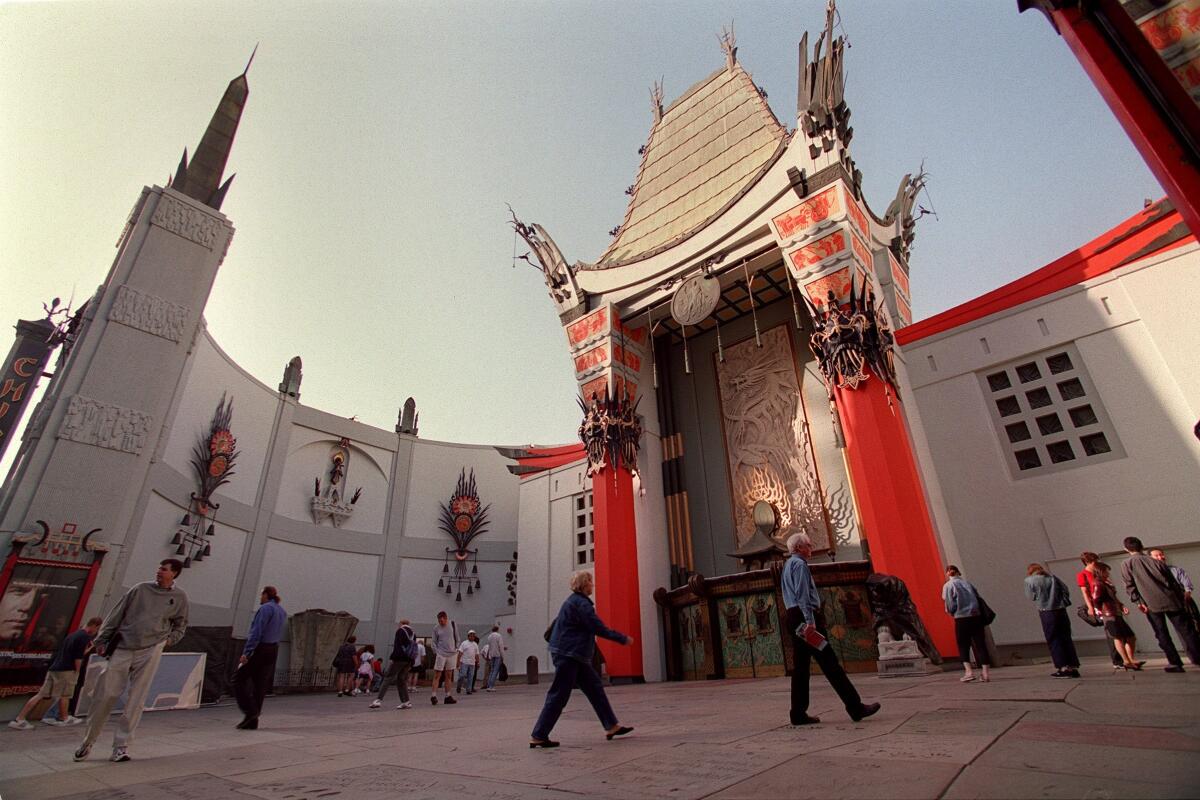
TCL (Grauman's) Chinese Theatre
Out front, the Chinese’s courtyard has handprints and footprints in cement from stars dating all the way back to the theater’s opening in 1927. Lots of them say “Thanks Sid, “To Sid,” “God bless you Sid” — except for Humphrey Bogart’s, which says, “Sid, may you never die til I kill you.” You’ll find prints from lots of cinema icons like Clark Gable, Debbie Reynolds and Sidney Poitier alongside more recognizable modern-day names like Emma Stone, Ryan Gosling, Regina King and all of the original Avengers. Prepare to marvel at how teeny-tiny some of the hands and feet are.
The 932-seat original theater inside has been thoroughly renovated. In 2013, what was then the world’s largest IMAX screen was installed. There’s an adjoining multiplex with six more screens, including one with MX4D seat-motion technology and another with D-BOX haptics.
The courtyard is free to explore. A security guard will stop you from poking your head into the theater unless you’re seeing a movie. Movie tickets can be purchased ahead of time online or on-site at the box office.
The El Capitan Theatre across the street almost always has kid-friendly films running. (It’s owned by Disney, and sometimes you can catch an organist playing Disney tunes before a show.) Ripley’s Believe It or Not! is a fun way to kill an hour before your movie starts — look for the seasonally attired T. rex towering over the intersection.
Locals know: Want to see a movie in the original Grauman’s theater? Look at the listings and book your seat for the one with “(IMAX)” in the title.
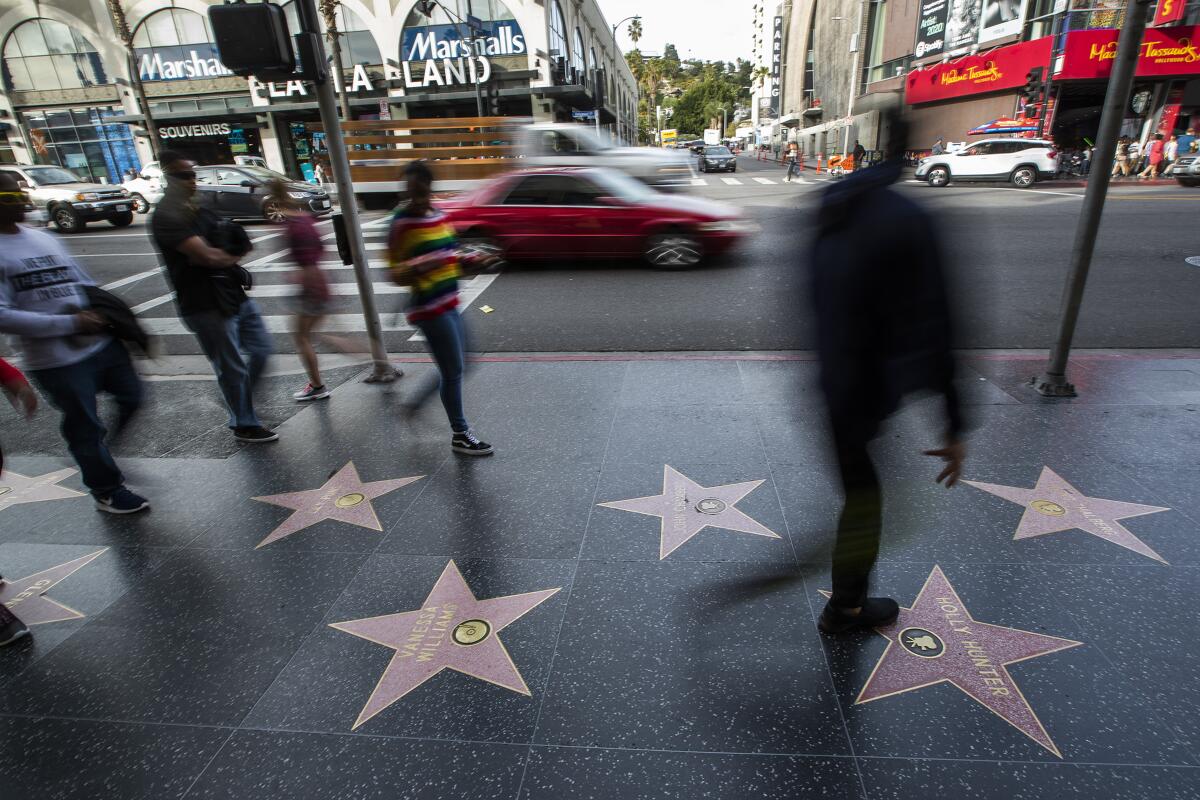
The Hollywood Walk of Fame
The Walk of Fame is really just terrazzo stars embedded in the sidewalk, and not the cleanest sidewalk in the world, either. And yes, technically speaking, it costs money to get a star here; they are not handed out strictly on merit. But those stars represent the culmination of generations of aspiring actors’ Hollywood dreams. After a celebrity dies, their star instantly becomes a public shrine. You can’t say there isn’t a little bit of magic here.
The Walk of Fame runs along Hollywood Boulevard and up some side streets east and west from La Brea to just past Gower, and on Vine from Yucca Street south to Sunset Boulevard. They are most densely clustered just outside of Ovation Hollywood. The Walk of Fame has a map so you can search out your favorite star’s star ahead of time. Grab a drink (and play a classic board game) at the Hollywood Roosevelt on your tour of the sidewalk stars.
Locals know: The costumed characters jumping into frame to take a photo with you expect payment (plus tip) after. Say no unless you’ve got cash on hand. Say yes to the food vendors selling cut fruit and bacon-wrapped hot dogs. In L.A., these are a treasured delicacy.
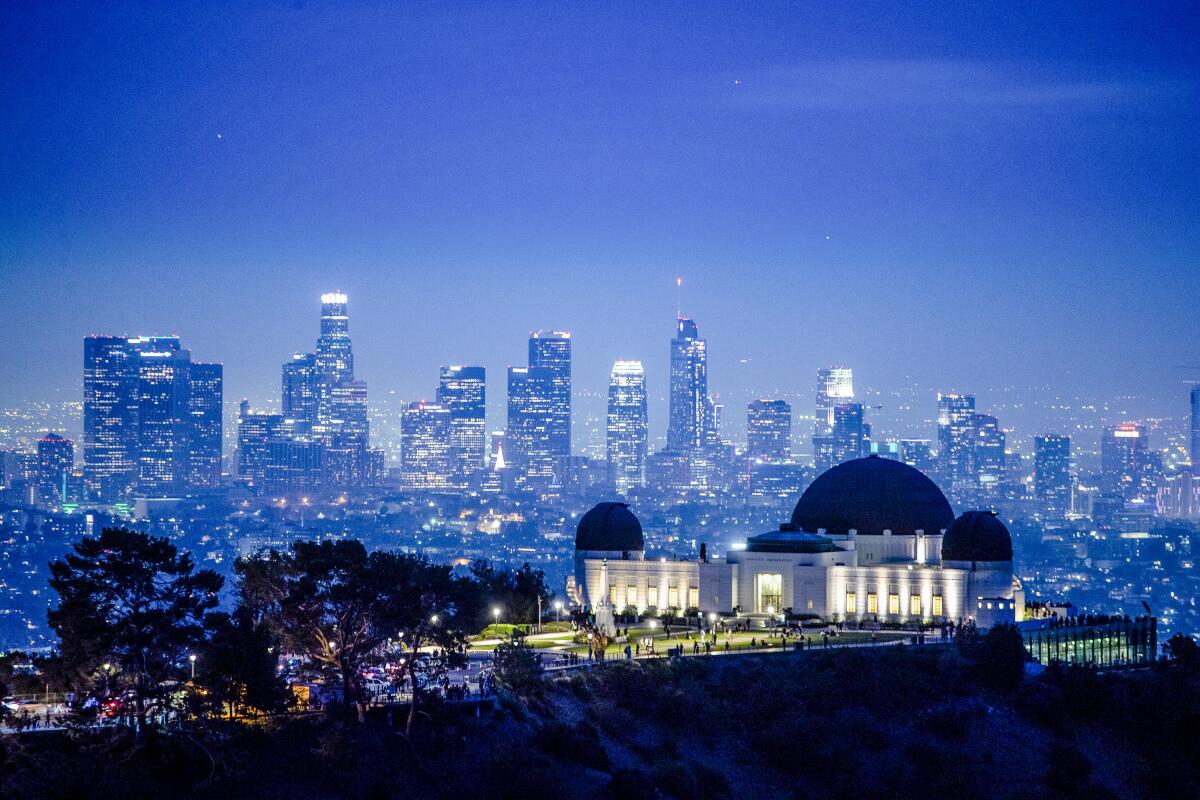
Griffith Observatory
Nestled into the Hollywood Hills, the Griffith Observatory has soaring views of the entire city, including the Hollywood sign and downtown. After you’ve taken in the splendor, there’s a ton more to do.
The observatory was built as a destination for public astronomy. There are several small permanent exhibits, including ones on California’s history as an epicenter of astronomy; the history of astronomical observing devices; and a working Tesla coil demonstrated at posted intervals throughout the day. You can watch a real Foucault pendulum in motion and cheer with the crowd when the 240-pound brass ball, suspended 40 feet from the ceiling, knocks over a tiny block every few minutes as the Earth turns beneath you.
If you want to see a show, arrive early: Attendees are asked to line up outside the planetarium 20 minutes prior to showtime. The shows last about 35 minutes. Kids under the age of 5 get free admission to planetarium shows but are only allowed at the first showing of the day.
The observatory is free. Tickets to the shows at the Samuel Oschin Planetarium cost extra: $10 for those age 13 and older; $8 for seniors, students and teachers; $6 for children age 5 to 12.
The Griffith Observatory is open from noon to 10 p.m. Tuesday to Friday and 10 a.m. to 10 p.m. Saturdays and Sundays. It is closed on Mondays.
Leave extra time to sort out parking. There is a small lot all the way at the top of the winding road through Griffith Park that leads to the observatory. It was already completely full within 30 minutes of opening on a random weekday in January. There are metered spots along the winding uphill road. For both the lot and meters, you have to pay $10 per hour ahead of time and display the receipt on your dashboard. There is free parking by the Greek Theatre, but it’s a milelong uphill trek to get from there to the observatory, and that lot is closed after 1 p.m. on concert days. There is also a public bus that drops you off at the observatory (50 cents for adults, free for kids).
Locals know: The observatory is inside Griffith Park. Despite its complicated namesake, there’s a lot to do there, including hiking, a carousel, steam-powered trains and the L.A. Zoo. Just don’t forget to feed your meter.
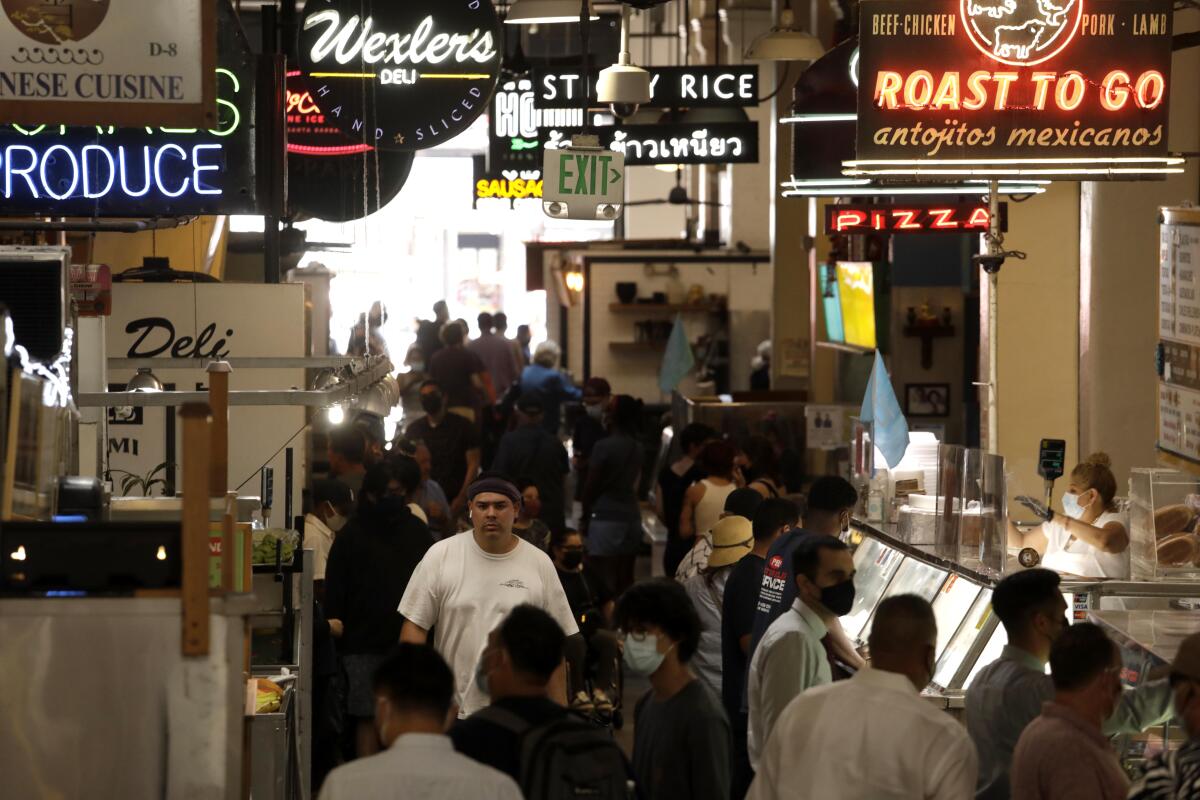
Grand Central Market
There are around 40 food stalls. You order individually at the registers, and then you can bring your food back to a communal table with your group. Even the pickiest eaters will find something they’ll like. Some food vendors accept only cash. There are ATMs.
I recommend making Grand Central Market your first or last stop on a mini self-guided tour of downtown L.A. Plan to pop into the Bradbury Building across the street, then take Angels Flight up and visit the secret garden at Walt Disney Concert Hall. After that, head to Olvera Street or Little Tokyo.
Grand Central is open from 8 a.m. to 9 p.m. every day. There is parking on-site at 308 S. Hill St. There are also lots of public surface lots and structures in downtown L.A. that offer flat-rate parking most days for $10 to $20. Most accept credit cards, but some are cash-only.
Locals know: A lot of the stalls here serve wine and beer, including local brewery Golden Road. Next door on the north side, La Cita slings margaritas in a cramped, old-school, Christmas-light-strewn bar with a leafy back patio.
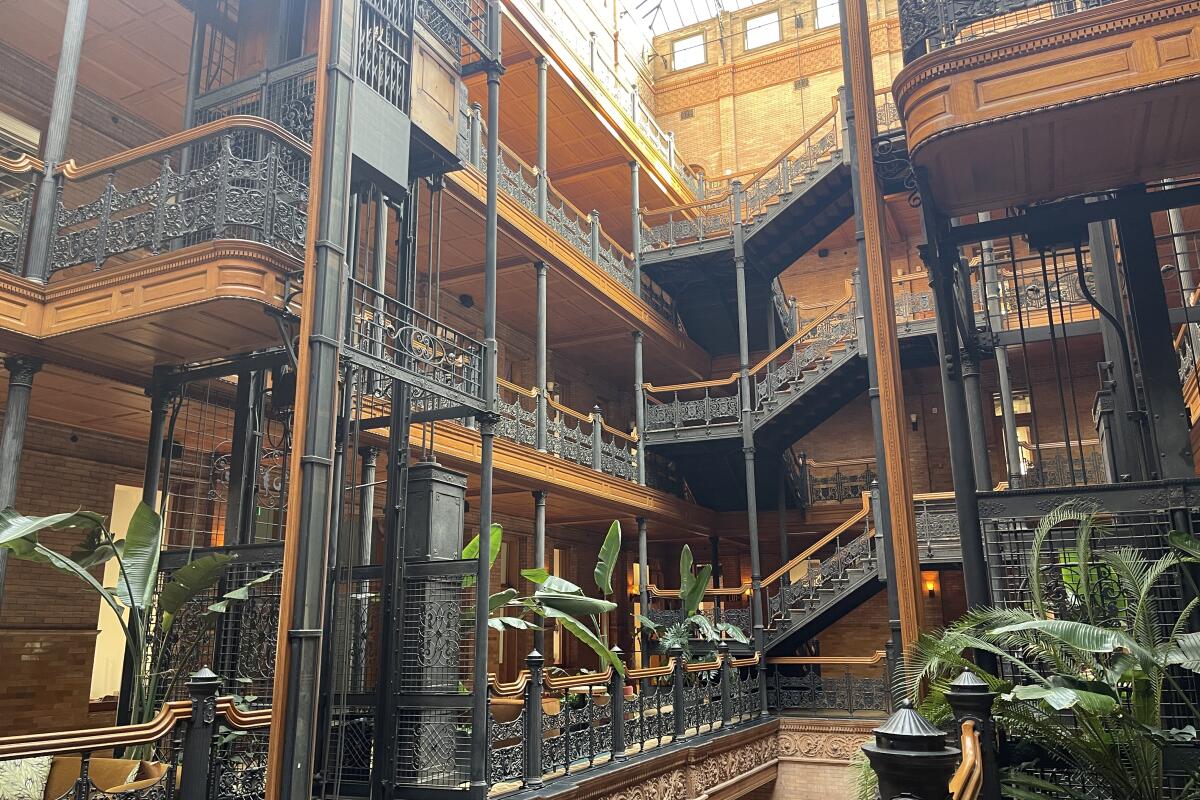
The Bradbury Building
There are multiple architectural walking tours of downtown Los Angeles that include the Bradbury Building, where tour guides will show you more of the inside.
Locals know: The Bradbury Building is a working office building, as it has been on and off since it was built in 1893. If you were there for a meeting, or looking to tour the NeueHouse co-working space inside, you would be able to go past the ground floor.
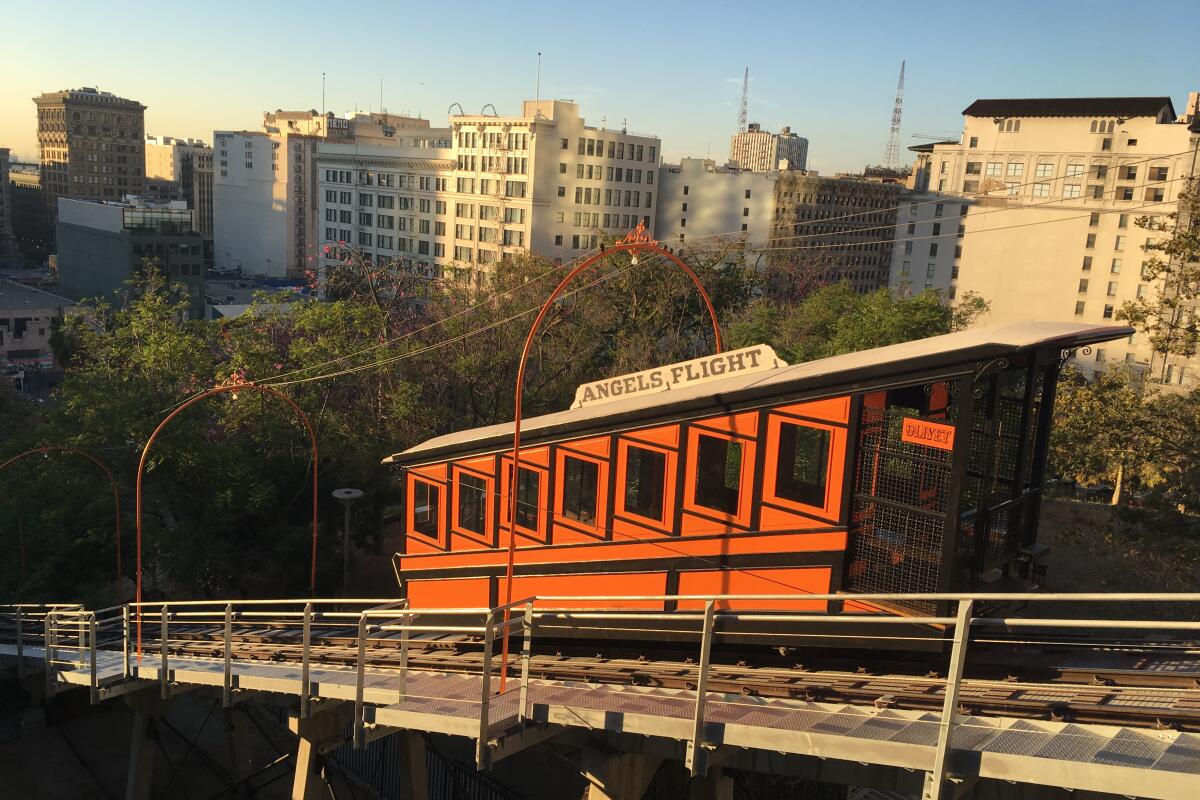
Angels Flight
Angels Flight reopened in 2017 after a three-year renovation. On the off chance it’s not running that day, there’s an adjacent stairway. Angels Flight is open from 6:45 a.m. to 10 p.m.
Locals know: At the top, walk through California Plaza and head east to see the Broad museum and Walt Disney Concert Hall. At the bottom, head across Hill Street to Grand Central Market, then check out the Bradbury Building on the other side.
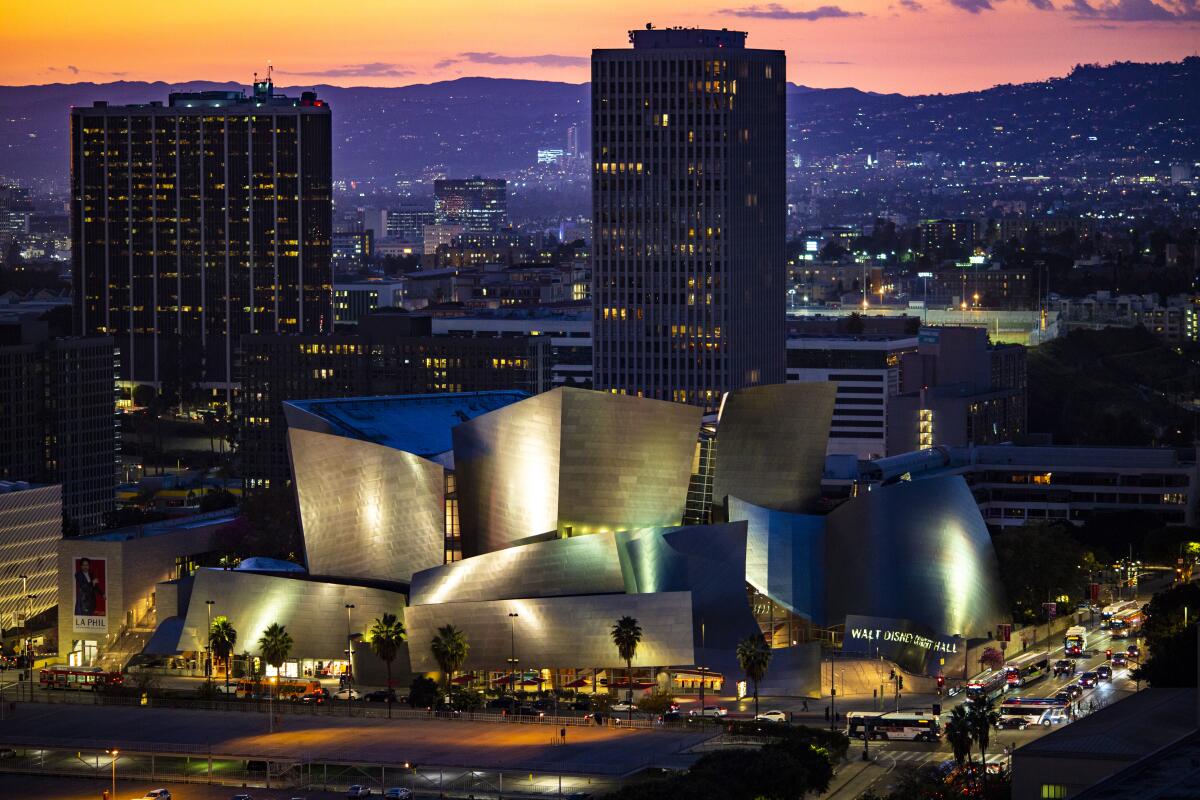
Walt Disney Concert Hall
When you arrive, take a moment on the sidewalk to behold the spaceship-esque design. Former L.A. Times architecture critic Christopher Hawthorne opined in 2013 on Frank Gehry’s vision, the “exuberance of the design, the way it seems eager to expand outward like a bunch of balloons in a child’s fist. … [It] responds to the lonely moonscape urbanism of Bunker Hill with a shimmering, canny gregariousness that spills down Grand Avenue in both directions. … This is a city where performance and civic self-image have always been intertwined, even inseparable.”
After you’ve had your fill of photo ops with the exterior, climb the steps at the southwest or northeast corners and find yourself immersed in the natural world. The hall is home to one of L.A.’s secret gardens. Walk the winding path through the 1-acre Blue Ribbon Garden and admire the plants and blooming trees. There are tables and chairs with views of the San Gabriel Mountains to the east.
The fountain at the center, also designed by Gehry, is named “A Rose for Lilly” — a tribute to Walt Disney’s widow, Lillian, who made the initial $50-million contribution for the concert hall to be built. It’s inlaid with tile fragments from more than 200 shattered Delft porcelain vases. Look closely for drawings, initials and other sneaky Easter eggs left by the artists who constructed it.
The W.M. Keck Foundation Children’s Amphitheatre, adjacent to the Blue Ribbon Garden, is a great place for kids to run around and burn off energy.
There aren’t posted hours for the Blue Ribbon Garden, but it’s often open early in the morning until late at night, including after concerts.
Locals know: The concert hall offers complimentary self-guided audio tours most days from 10 a.m. to 3 p.m. You can use your smartphone or rent a device for an extra fee. Tour availability may change based on the concert schedule; check out the Music Center’s website for more information and dates.
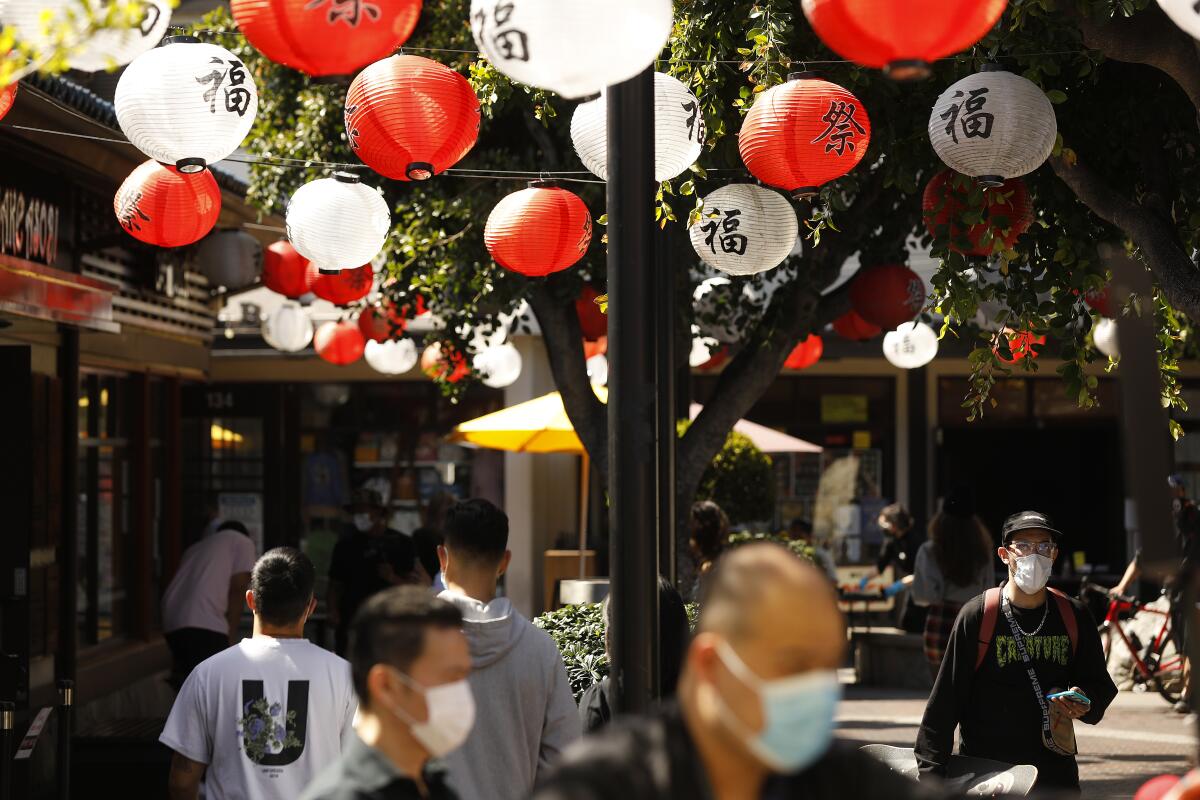
Little Tokyo
If you work up a bigger appetite, lots of iterations of Japanese cuisine are represented here — including sushi, ramen, shabu-shabu, bakeries, a tea room, boba and coffee shops. The Japanese American National Museum and the Museum of Contemporary Art are along the east end.
The main pavilion is pedestrian-only, which makes it feel like you’ve teleported out of car-centric downtown. The whole area is only a few blocks, but if you like food, bars, cultural history or fun shopping, it’s easy to spend a few hours here. Far Bar is a popular spot for drinks.
Little Tokyo is less than a mile from Grand Central Market, so you can add it to your downtown L.A. mini-tour if you have time. There are parking structures around Little Tokyo, many of which are cash-only. There is some metered street parking.
Locals know: Finish your milk tea before you shop. Most of the stores forbid drinks.
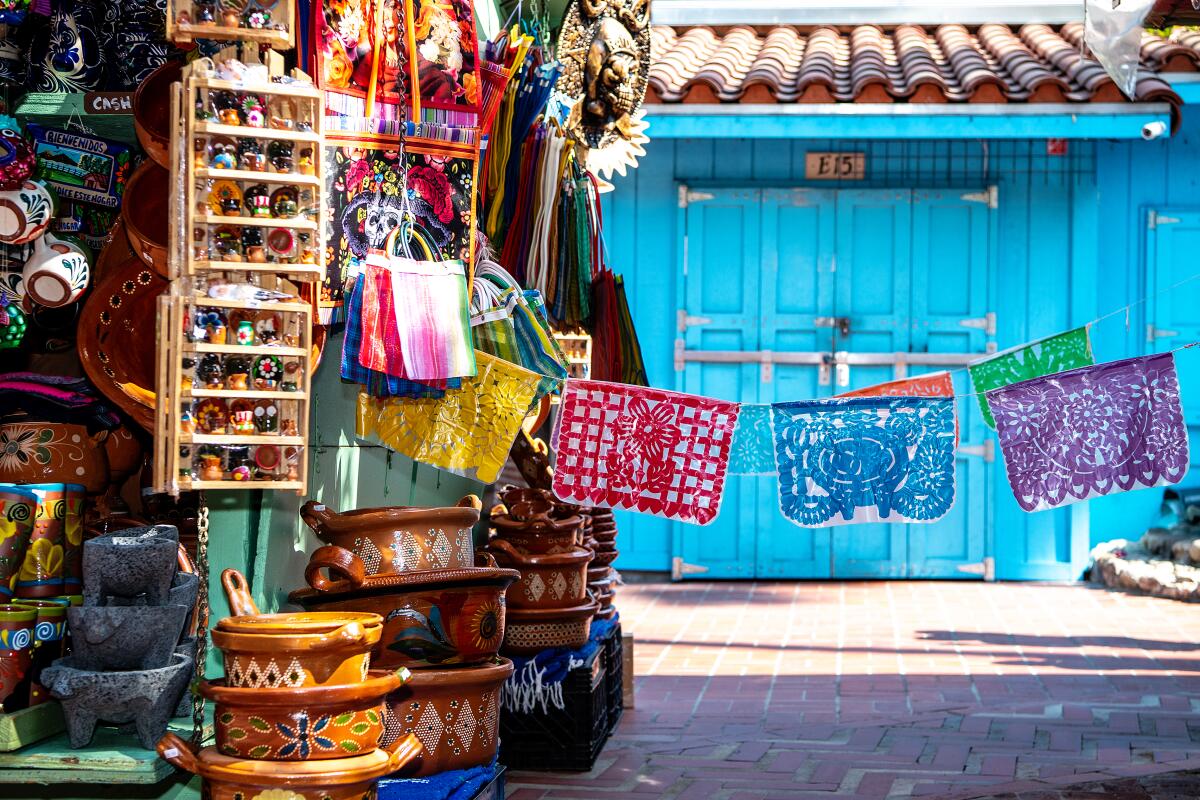
Olvera Street
There’s also a small museum called LA Plaza de Cultura y Artes just north of the plaza that has art and artifacts from Latinx artists and spotlights Los Angeles history. It’s free and open from noon to 5 p.m. Wednesday to Sunday.
Like Little Tokyo, the Olvera Street area is walkable from the downtown hub on this guide, though you do have to cross a freeway overpass. There are surface lots in the area. Some accept credit cards, but some are cash-only. If you’re taking public transit, get off at Union Station. Official hours for the marketplace are 10 a.m. to 7 p.m.; some stores and stalls may open earlier or close later.
Locals know: L.A.’s Chinatown is just a couple blocks north, though it isn’t as large or impressive as the ones in San Francisco or New York City. Philippe’s, one of two places in downtown L.A. that claim to be the original home of the French dip, is just up Alameda Street.
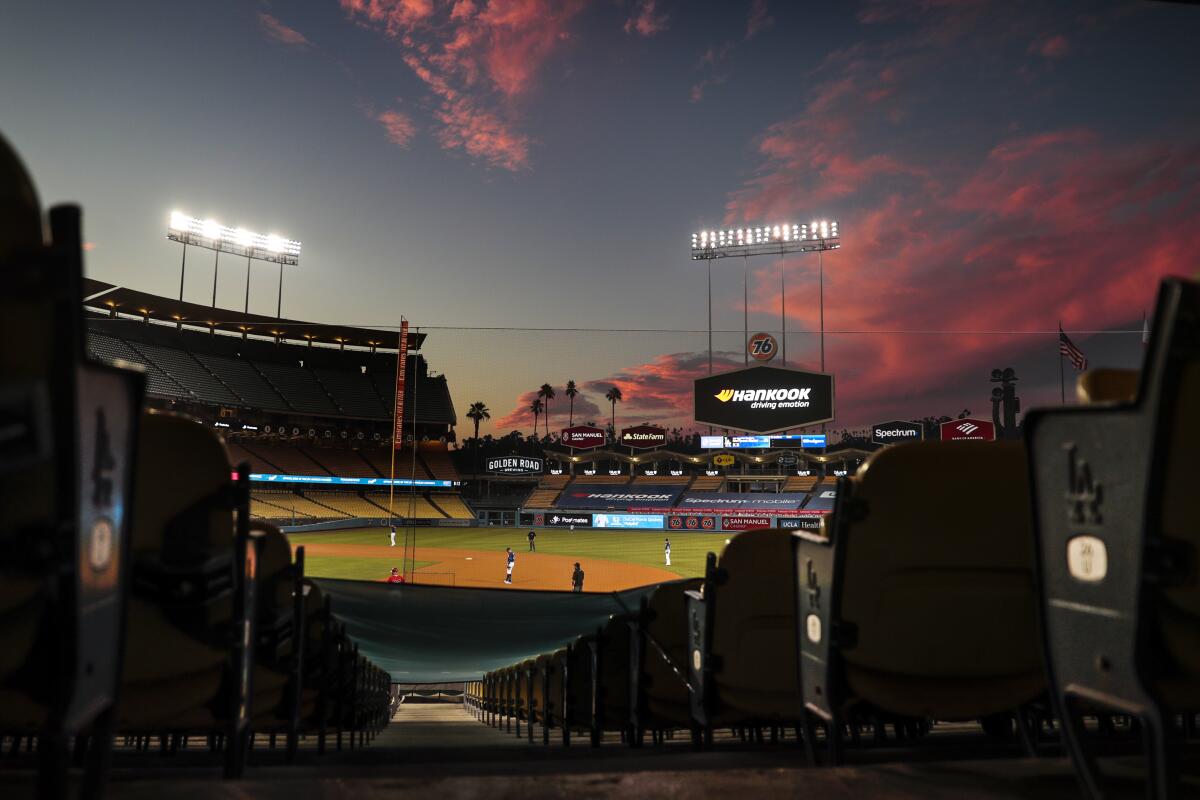
Dodger Stadium
L.A. Times Dodgers reporter Jack Harris wrote about the enduring appeal of Dodger Stadium: Fans “don’t come for modern amenities. They don’t see many cutting-edge features. They aren’t dazzled by architectural advancements. This place offers something different. A portal to the past. A connection to the present. And, even after all this time, a sporting and cultural touchstone destined to last well into the future. … Indeed, while many venues could be called one of baseball’s spiritual homes, Dodger Stadium is near the top of the list.”
The food offerings are way better than your typical ballpark fare — check out the Doyer Dog and carne asada nachos in a helmet. There’s even a botanic garden. All of that aside: It’s worth the price of entry for the sunset views alone.
Tickets for Dodger games are shockingly cheap compared to a lot of other stadiums around the country: A recent scan of games in the 2023 season pulled up plenty of bleacher seats in the $20 to $40 range. (If you’re visiting outside of baseball season, you might still be able to visit — it’s a popular concert venue.)
The parking situation at Dodger Stadium is complicated. There’s parking on-site, though it’s notoriously time-consuming to fight through the winding roads around Chavez Ravine and the thickly congested lots before and after a game. That’s part of where the “arrive late, leave early” lore comes from: Angelenos love the Dodgers, but they love beating traffic even more. The Dodgers’ website has information on directions, parking, shuttles and ride-share or public transit options.
Locals know: The Short Stop bar nearby opens two hours before home games and has a happy hour from 5 to 9 p.m.
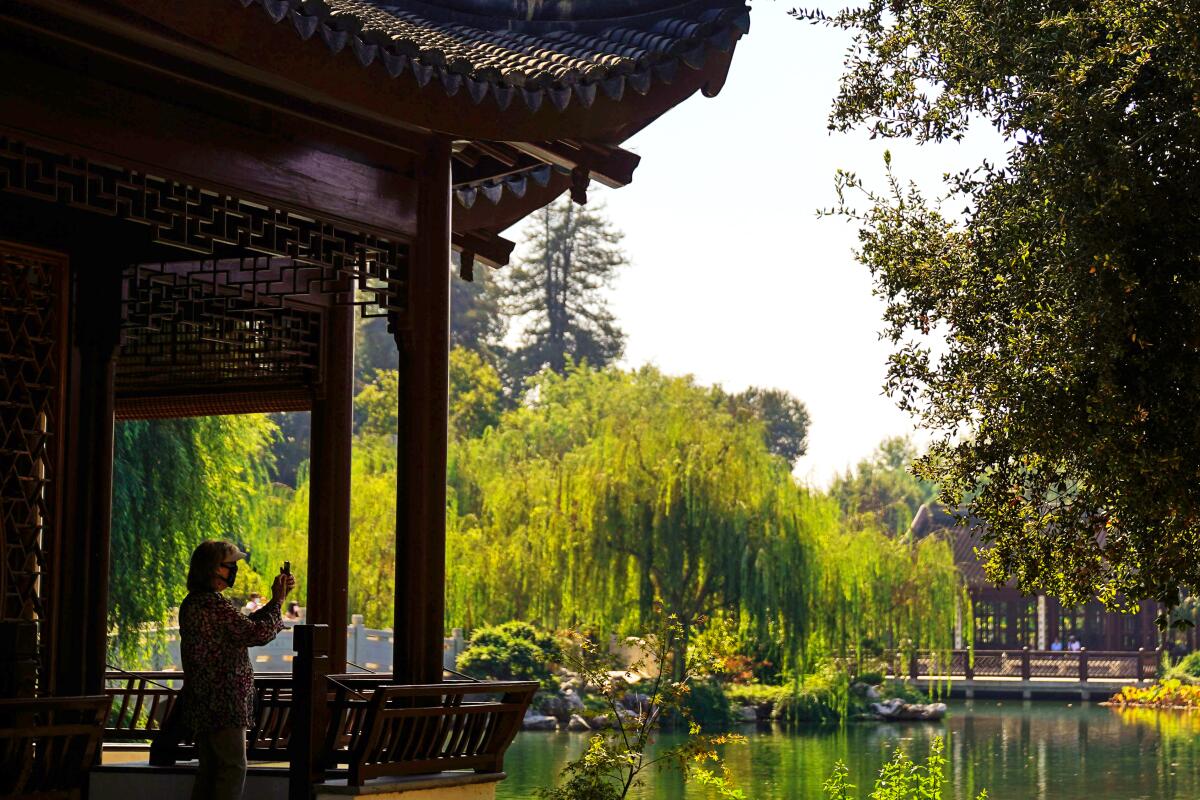
The Huntington
It’s best known for the plant life: There are 16 themed gardens, including a Chinese Garden, lily ponds, a conservatory of humidity-loving species and areas dedicated to greenery from California, Australia, the desert and the subtropics. There’s even one inspired by the works of Shakespeare. You’ll recognize a lot of spots as backdrops from movies and TV shows, including “The Good Place,” “Parks and Recreation,” “Scandal” and many more.
The gardens are at their most spectacular when the Rose Garden is in bloom — which spans from late March through Thanksgiving — but I’ve visited in the dead of winter and gotten a full day out of it.
The library has volumes dating back to the 11th century. Anyone can peruse the books, maps and other pieces from the library’s permanent collection on display. In between the gardens are galleries filled with European, American and Asian art.
If your visitors are interested in art, the outdoors, rare books or California history, make plans to spend significant time here. Don’t miss the Children’s Garden, which has kid-sized fountains, a hedge maze and lots of things to touch and climb through, on and under. Wear comfortable shoes.
Ticket reservations are required for weekends and strongly encouraged for weekdays. Weekend tickets are $29 for adults; $24 for seniors, students and military; $13 for kids age 4 to 11; and free for children under the age of 4. There is a large dedicated surface lot and parking is free. The Huntington is open from 10 a.m. to 5 p.m. daily except Tuesday. It’s open year-round except for New Year’s Day, July 4, Thanksgiving, Christmas Eve and Christmas Day.
If you happen to be here on the second Sunday of the month, the Rose Bowl Flea Market is not far.
Locals know: The Huntington offers free tickets for the first Thursday of every month. Those “Free Day” tickets are limited and are released at 9 a.m. on the last Thursday of the month. You need to secure one of those tickets for entry. Limit five per household.
Sign up for This Evening's Big Stories
Catch up on the day with the 7 biggest L.A. Times stories in your inbox every weekday evening.
You may occasionally receive promotional content from the Los Angeles Times.



